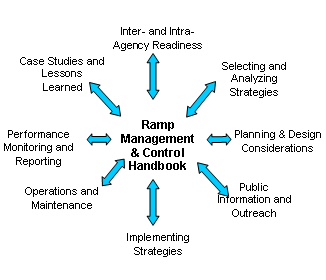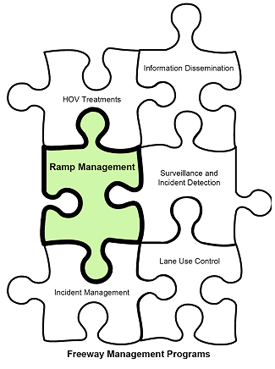What is Ramp Management?
Ramp Management is the…“application of control devices, such as traffic signals, signing, and gates to regulate the number of vehicles entering or leaving the freeway, in order to achieve operational objectives”.
Ramp Management Strategies
There are four accepted and proven strategies to manage ramp-based traffic:
Ramp Metering - The use of traffic signal(s) deployed alongside a ramp to control the rate at which vehicles enter a freeway facility.
Ramp Closure - Ramp closure involves the use of gates, barriers or cones to restrict vehicle access to a ramp. Closures can be permanent, temporary, or scheduled.
Special Use Treatments - Special use treatments give “special” consideration to a vehicle class or classes to improve safety, improve traffic conditions, and/or encourage specific types of driving behavior.
Ramp Terminal Treatments - Ramp terminal treatments are solutions to problems that occur at or near ramp/arterial intersections.
Ramp management is one of the most cost effective and proven tools available for improving the operations and safety of freeways and adjacent arterials. For example, the ramp metering system in Minneapolis yields a benefit-to-cost ratio of over 15:1. |
Ramp Management Benefits
Ramp management strategies may produce the following benefits:
Safety – Ramp management improves the flow and mix of vehicles that enter/exit a freeway. In Denver, freeway crashes decreased by 50 percent.
Mobility and Reliability - Ramp management improves mobility and reduces congestion, which in turn results in increased travel speeds and reduced travel times. In Detroit, average speeds and volumes increased by 8 and 14 percent, respectively.
Environmental – By reducing congestion, decreasing delay, and improving speeds, ramp management has also been shown to reduce the total amount of vehicle pollutants released into the environment. In Minneapolis, ramp metering reduced overall emissions by 1,160 tons annually.
When not properly planned and deployed, ramp management strategies can have negative impacts. Vehicle diversion onto surface streets, queue spillback from ramps onto adjacent freeways or arterials, and localized emission problems around ramps are all impacts that need to be considered and addressed before strategies are implemented.
Our region first installed ramp metering in our state's largest urban area in the early 1980s and we have steadily expanded the system since then. Other, smaller cities in our state have seen the benefits and are planning ramp meter systems. Every evaluation of the system has shown reduced accidents, reduced delay and increased volumes when metering was installed. No other traffic management strategy has shown the consistently high level of benefits in such a wide range of deployments from all parts of the country.
– Pete Briglia, Puget Sound Regional Council and Chair of the TRB Freeway Operations Committee. |
|
What is the Ramp Management and Control Handbook?
The Ramp Management and Control Handbook provides guidance and recommended practices on managing and controlling traffic on freeway entrance and exit ramps. The Handbook provides a comprehensive, single source for practitioners looking to implement new, or improve the operation of existing, ramp management strategies. Use of the Handbook is intended to improve the safety, mobility, reliability, and environmental impacts of ramps and their surrounding freeways and arterials.
The Handbook addresses several key topics associated with planning, designing, implementing, operating, and maintaining ramp management strategies. Some of these key topics are highlighted below.

The Relationship between Ramp Management and Freeway Management
Ramp management is a single function that typically falls under the freeway management umbrella. Ramp management elements work with other elements of freeway management (e.g., HOV Treatments and Incident Management) to deliver freeway management system goals and objectives. This relationship can be likened to puzzle pieces with ramp management representing one of the pieces that need to collectively come together to ensure successful operations. In addition to freeway management, ramp management should also be coordinated closely with arterial management, transit management, and other parts of the overall surface transportation system.

The Ramp Management and Control Handbook and other ramp management information and resources can be downloaded at the following URL: http://ops.fhwa.dot.gov/freewaymgmt/index.htm |